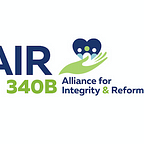In recent weeks, the 340B program has resurfaced as a topic of interest for policymakers and patient advocates alike. As the Alliance for Integrity and Reform of 340B (AIR340B Coalition), we are encouraged that much of this interest is geared toward ensuring the sustainability of the program for the future and strengthening it to make sure it serves vulnerable or uninsured patients. However despite this recent increased interest in the program, it is still relatively unknown.
The 340B drug discount program was created to help certain health care safety-net providers that serve a large number of uninsured or otherwise vulnerable patients reduce prescription drug costs by requiring drug manufacturers to provide deep discounts on medicines. For example, the 340B drug discount program provides discounted drugs to community health centers, cancer hospitals, children’s hospitals, and clinics for Indian Health, HIV/AIDS, Black Lung, Hemophilia, and Tuberculosis.
Our Coalition’s diverse membership is indicative of our goal to make improvements that lead to better health outcomes for the neediest patient populations. The AIR340B Coalition is comprised of patient advocacy groups, clinical care providers, and biopharmaceutical innovators, and we believe in preserving the intent of the 340B program. When Congress created the program in 1992, it was relatively small and targeted only toward those entities that truly served the most needy patients. Few hospitals participated in the program at first and initially the clinics and hospitals that participated predominantly focused on serving vulnerable or uninsured patients who truly could not afford to access prescription medications.
Since then, poor oversight and lack of clear program rules have led to a rapid expansion of the program. It is not clear, however, that vulnerable or uninsured patients are the beneficiaries of this expansion. Today, DSH hospitals, which are only about 9 percent of 340B entities, represent 80 percent of sales associated with the 340B drug discount program, and they are rapidly expanding. One source of this expansion is the increased use of 340B discounts by hospital-acquired outpatient clinics. These clinics are often in wealthier areas than the 340B hospitals but, once acquired, are able to obtain 340B discounts, even though they do not share the hospital’s obligations to treat uninsured patients. Another concerning source of growth stems from a 2010 change to the program that vastly expanded the role of for-profit retail pharmacies in the 340B program. Hospitals are allowed to partner with an unlimited number of these pharmacies, which then share in 340B profits. A recent Office of the Inspector General study that scrutinized these arrangements found many of the hospitals required uninsured patients who filled their 340B prescriptions at retail pharmacies to pay full price for their medicines.
Recently, POLITICO looked at the top seven hospitals as ranked by U.S. News & World Report, of which more than half are 340B, and found that those hospitals’ charity care fell by 35 percent between 2013 and 2015 while their combined revenue increased by $4.5 billion. Further, more than one-third of 340B disproportionate share hospitals (DSH) provide charity care that represents less than 1 percent of their total patient costs.
We believe many covered entities are providing critical services to uninsured or vulnerable patients, but at the same time, studies show that there are a number of hospitals taking advantage of the program with little to no benefit to patients.
As a Coalition, we believe there are several ways the program could be fixed to ensure it meets its original intent. We suggest three key areas for change:
1. Define a 340B Eligible Patient: The 340B statute clearly states that covered entities are not permitted to provide 340B discounted drugs to individuals who are not their patients. Unfortunately, that has proved difficult to enforce at 340B hospitals due to a lack of clarity regarding the definition of a 340B eligible patient and hospitals’ complex operating structures.
2. Tighten Hospital Eligibility Standards and Curb Incentives for Consolidation: Tighter rules around which hospitals and patient eligibility are needed to ensure discounts are targeted to facilities truly serving the uninsured or vulnerable. Also changes are needed to curb the financial incentives driving 340B hospitals to acquire community-based physician practices, particularly given the substantial increase in health care costs associated with the site of care shifting from physician offices to hospital facilities in the last decade.
3. Restrict Contract Pharmacy Arrangements: Under current guidance, all covered entities are permitted to contract with multiple outside, for-profit retail pharmacies that share in the profits from the 340B program. New policies are needed to address the dramatic growth of contract pharmacy arrangements between 340B entities and for-profit, retail pharmacies.
We look forward to fixing the 340B program by working with Congress, the Administration and other stakeholders to ensure the program is sustainable and achieves its intended goal of helping the neediest patients access the care they need through federally-funded clinics and true safety net hospitals. If you are passionate about preserving and strengthening the 340B program, and want to learn more about the work that AIR340B is doing, please contact info@340breform.org.
